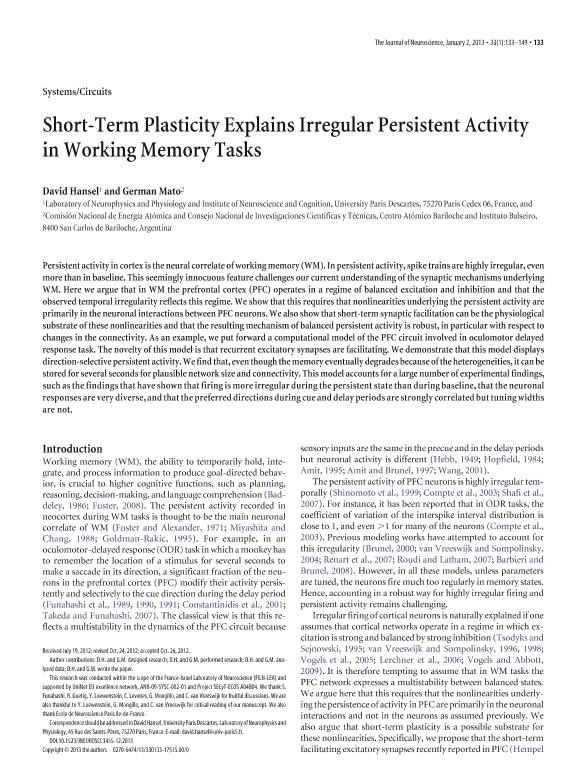Artículo
Short-term plasticity explains irregular persistent activity in working memory tasks
Fecha de publicación:
01/2013
Editorial:
Society for Neuroscience
Revista:
Journal of Neuroscience
ISSN:
0270-6474
e-ISSN:
1529-2401
Idioma:
Inglés
Tipo de recurso:
Artículo publicado
Clasificación temática:
Resumen
Persistent activity in cortex is the neural correlate of working memory (WM). In persistent activity, spike trains are highly irregular, even more than in baseline. This seemingly innocuous feature challenges our current understanding of the synaptic mechanisms underlying WM. Here we argue that in WM the prefrontal cortex (PFC) operates in a regime of balanced excitation and inhibition and that the observed temporal irregularity reflects this regime. We show that this requires that nonlinearities underlying the persistent activity are primarily in the neuronal interactions between PFC neurons. We also show that short-term synaptic facilitation can be the physiological substrate of these nonlinearities and that the resulting mechanism of balanced persistent activity is robust, in particular with respect to changes in the connectivity. As an example, we put forward a computational model of the PFC circuit involved in oculomotor delayed response task. The novelty of this model is that recurrent excitatory synapses are facilitating. We demonstrate that this model displays direction-selective persistent activity. We find that, even though the memory eventually degrades because of the heterogeneities, it can be stored for several seconds for plausible network size and connectivity. This model accounts for a large number of experimental findings, such as the findings that have shown that firing is more irregular during the persistent state than during baseline, that the neuronal responses are very diverse, and that the preferred directions during cue and delay periods are strongly correlated but tuning widths are not.
Palabras clave:
Memoria
,
Dinamica
,
Plasticidad
Archivos asociados
Licencia
Identificadores
Colecciones
Articulos(CCT - PATAGONIA NORTE)
Articulos de CTRO.CIENTIFICO TECNOL.CONICET - PATAGONIA NORTE
Articulos de CTRO.CIENTIFICO TECNOL.CONICET - PATAGONIA NORTE
Citación
Hansel, David; Mato, German; Short-term plasticity explains irregular persistent activity in working memory tasks; Society for Neuroscience; Journal of Neuroscience; 33; 1; 1-2013; 133-149
Compartir




